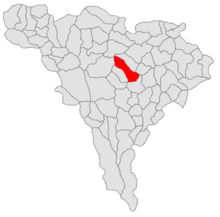Galda de Jos
|
Galda de Jos Unterhanenberg Alsógáld |
||||
|
||||
| Basic data | ||||
|---|---|---|---|---|
| State : |
|
|||
| Historical region : | Transylvania | |||
| Circle : | Alba | |||
| Coordinates : | 46 ° 11 ' N , 23 ° 38' E | |||
| Time zone : | EET ( UTC +2) | |||
| Height : | 266 m | |||
| Area : | 101.69 km² | |||
| Residents : | 4,516 (2011) | |||
| Population density : | 44 inhabitants per km² | |||
| Postal code : | RO-517285 | |||
| Telephone code : | (+40) 02 58 | |||
| License plate : | FROM | |||
| Structure and administration (as of 2012) | ||||
| Community type : | local community | |||
| Structure : | Galda de Jos, Benic , Cetea , Galda de Sus , Lupșeni , Măgura , Mesentea , Oiejdea , Poiana Galdei , Răicani , Zăgriș | |||
| Mayor : | Romulus Raica ( PNL ) | |||
| Postal address : | Str. Principală, no. 90 loc. Galda de Jos, jud. Alba, RO-517285 |
|||
| Website : | ||||
Galda de Jos ( German Unterhanenberg , Hungarian Alsógáld ) is a Romanian municipality in the Alba district in Transylvania .
Geographical location
The municipality of Galda de Jos extends with the ten incorporated villages on an area of 10,169 hectares on the eastern edge of the Trascău Mountains in western Transylvania in the middle of the Alba district. Three kilometers west of the European route E 81 ( Aiud - Alba Iulia ), the place is located on the Galda River , a tributary of the Mureș (Mieresch) . It is about 6 kilometers to the next town of Teiuș ; the district capital Alba Iulia is about 10 kilometers south of Galda de Jos.
history
The place Galda de Jos was first documented in 1287 under the name Gald (1854 Also-Gald ). Most of the incorporated villages are mentioned between the 13th and 14th centuries ( Benic 1299, Cetea 1337, Mesentea 1303, Oiejdea 1238).
In the 14th century the Roman road , the stone path Via Magna , is mentioned here.
Today the inhabitants live mainly from agriculture, cattle breeding, beekeeping, fruit growing and viticulture.
population
The population of the municipality developed as follows:
| census | Ethnic composition | |||||||
|---|---|---|---|---|---|---|---|---|
| year | population | Romanians | Hungary | German | other | |||
| 1850 | 5,027 | 4,347 | 395 | 2 | 283 | |||
| 1900 | 5,899 | 5,293 | 572 | 30th | 4th | |||
| 1956 | 5,619 | 4,992 | 569 | 3 | 55 | |||
| 1992 | 4,863 | 4,268 | 568 | 4th | 23 | |||
| 2002 | 4,882 | 4,277 | 553 | 12 | 40 | |||
The highest population (6394) of the municipality was determined in 1941; that of the Romanians (5806) in 1930, the Germans (43) in 1890, the Magyars (590) in 1910 and that of the Roma (180) in 1850. In 1880 and 1930, one Serb was registered , and in 1910 six Croatians .
Attractions
- The Romanian Orthodox Church Naşterea Maicii Domnului from the 17th century, with valuable paintings in two layers, is mentioned in 1715 and is a listed building.
- The Kemény Castle of the Kemény family was built in the 19th century. The east walls of the old castle, destroyed by farmers, are still standing.
- In the incorporated village of Benic ( Bendesdorf ) there are remains of a fortified church with a Gothic altar from the 15th century; the nave was rebuilt in the 17th century. The church is a listed building.
- The Romanian Orthodox Church Sf. Arhangheli in the incorporated village of Galda de Sus ( Oberhahnenberg ), built in the 17th century and rebuilt in 1800, is a listed building.
Web links
Individual evidence
- ↑ Mayoral elections 2016 in Romania ( MS Excel ; 256 kB)
- ^ Dictionary of the localities in Transylvania
- ↑ Sketch of the community area at comuna-galda.ro ( Memento from February 15, 2016 in the Internet Archive )
- ↑ a b http://www.sate-comune.ro/descriere_comuna.php?comuna=Galda-de-Jos ( Memento of April 13, 2010 in the Internet Archive ) History of Galda de Jos, accessed on sate-comune.ro on February 12, 2010 (Romanian)
- ↑ a b c Heinz Heltmann, Gustav Servatius (ed.): Travel Guide Siebenbürgen. Kraft-Verlag, Würzburg 1993, ISBN 3-8083-2019-2 .
- ↑ Census, last updated October 30, 2008, p. 84 (Hungarian; PDF; 1.1 MB)
- ↑ a b c List of historical monuments of the Romanian Ministry of Culture, updated 2010 (PDF; 7.10 MB)
- ↑ Information on the church, accessed on June 5, 2011 (Hungarian)




